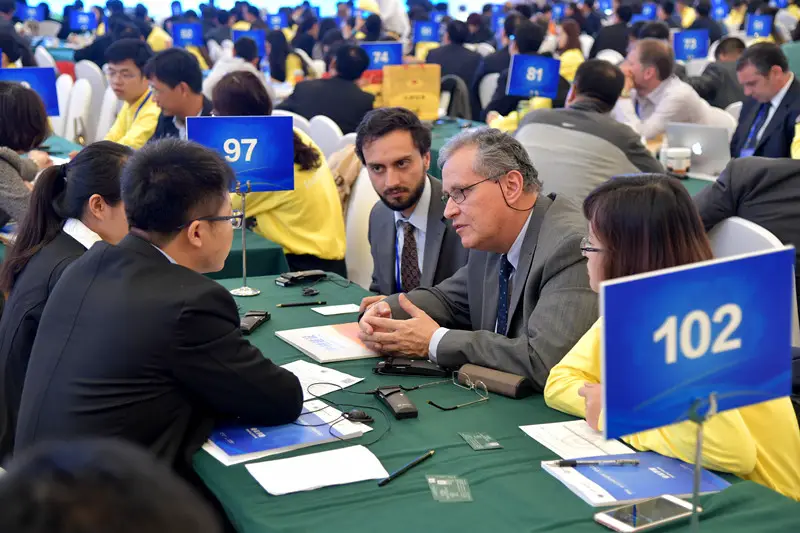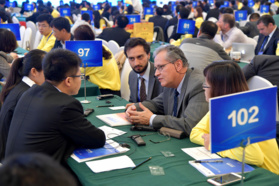By Wu Hongying Source: People’s Daily and Global Times
From November 17 to 23, Chinese President Xi Jinping is on a week-long visit to three Latin American countries - Ecuador, Peru and Chile. During the trip, he also attended the 24th Asia-Pacific Economic Cooperation (APEC) Economic Leaders' Meeting on November 19 and 20 in Lima, Peru. New bright spots are expected to develop in the economic and trade cooperation between China and Latin America following deepened communication.
In bilateral trade and economic cooperation, China and Latin America aim to shift toward an appropriate balance, rather than a model based on high trade volume but insufficient investment. In 2015, trade between China and Latin American countries reached $236.5 billion, and China's outbound investment into Latin America has grown at a rapid pace, reaching a cumulative amount of $120 billion.
In addition, financial development between China and Latin America has been generally smooth. Some Chinese commercial banks have established branches in Latin America, and according to Xinhua News, the first yuan-clearing bank was opened in Chile in June.
In all, trade and investment, as well as financial development have been properly balanced between China and Latin America.
As outbound Chinese investment into Latin America rises, concerns have surfaced about Latin America's political volatility and social unrest, along with doubts over whether Chinese capital will be paid back. In fact, Latin American countries have a comparatively sound democratic system, and its markets have developed a certain ability to withstand risk after many years of development.
At present, Chinese enterprises' inability to be paid back doesn't seem to be a problem, as there is cooperation between China and Latin American nations both at the government and the enterprise level. In addition, as some Chinese investment in Latin America is based on government-to-government deals and is adapted to local market rules, it can effectively curb risks. Meanwhile, the trade structure between China and Latin America is complementary, which has helped in strengthening bilateral cooperation.
But indeed, there are certain issues regarding China's investment in Latin America that need to be resolved. First, a gap can be seen between Latin American countries' high expectations for China and in the investment capability of Chinese enterprises. Latin American countries have high hopes that Chinese capital can help to improve their domestic infrastructure, but it will be difficult for Chinese enterprises to satisfy their needs entirely.
Second, the fact that Chinese investment concentrates only on a few Latin American nations continues to be a problem, creating an imbalanced overall investment situation in Latin America.
And third, China's State-owned enterprises (SOEs) have played the major role in investing in Latin America, whereas China's small and medium-sized enterprises (SMEs) have played a much smaller part.
However, following President Xi's visit to Latin America, investment from China is projected to increase and the imbalanced investment situation in the region is likely to improve. In the long run, Chinese enterprises need to strengthen their own capability in conducting investment activities. Meanwhile, apart from mainly investing in certain Latin American countries, Chinese companies need to direct more resources into other countries in the region that have received less Chinese capital.
The key topics at this year's APEC summit included upgrading SMEs' development and enhancing their participation in global value chains. This would allow China's SMEs to play an increasingly important role in its "going out" strategy and further facilitate the flow of capital from Chinese SMEs into Latin America. China's large SOEs have been the main players in investing overseas, but given China's excess industrial capacity, investment in Latin America by Chinese SMEs is expected to further complement cooperation in industrial capacity.
In January 2015, at the Forum of China and the Community of Latin American and Caribbean States, President Xi set goals for bilateral trade with Latin America and the Caribbean to reach $500 billion in the coming decade, with China's direct investment amounting to $250 billion, according to Xinhua News. This demonstrates China's intention to cooperate with Latin American countries. Following President Xi's third visit to Latin America, new cooperation initiatives are expected to be signed, and both sides will strive to achieve the goals for bilateral trade and investment.
(The author is director of the Institute of Latin American Studies with the China Institute of Contemporary International )
From November 17 to 23, Chinese President Xi Jinping is on a week-long visit to three Latin American countries - Ecuador, Peru and Chile. During the trip, he also attended the 24th Asia-Pacific Economic Cooperation (APEC) Economic Leaders' Meeting on November 19 and 20 in Lima, Peru. New bright spots are expected to develop in the economic and trade cooperation between China and Latin America following deepened communication.
In bilateral trade and economic cooperation, China and Latin America aim to shift toward an appropriate balance, rather than a model based on high trade volume but insufficient investment. In 2015, trade between China and Latin American countries reached $236.5 billion, and China's outbound investment into Latin America has grown at a rapid pace, reaching a cumulative amount of $120 billion.
In addition, financial development between China and Latin America has been generally smooth. Some Chinese commercial banks have established branches in Latin America, and according to Xinhua News, the first yuan-clearing bank was opened in Chile in June.
In all, trade and investment, as well as financial development have been properly balanced between China and Latin America.
As outbound Chinese investment into Latin America rises, concerns have surfaced about Latin America's political volatility and social unrest, along with doubts over whether Chinese capital will be paid back. In fact, Latin American countries have a comparatively sound democratic system, and its markets have developed a certain ability to withstand risk after many years of development.
At present, Chinese enterprises' inability to be paid back doesn't seem to be a problem, as there is cooperation between China and Latin American nations both at the government and the enterprise level. In addition, as some Chinese investment in Latin America is based on government-to-government deals and is adapted to local market rules, it can effectively curb risks. Meanwhile, the trade structure between China and Latin America is complementary, which has helped in strengthening bilateral cooperation.
But indeed, there are certain issues regarding China's investment in Latin America that need to be resolved. First, a gap can be seen between Latin American countries' high expectations for China and in the investment capability of Chinese enterprises. Latin American countries have high hopes that Chinese capital can help to improve their domestic infrastructure, but it will be difficult for Chinese enterprises to satisfy their needs entirely.
Second, the fact that Chinese investment concentrates only on a few Latin American nations continues to be a problem, creating an imbalanced overall investment situation in Latin America.
And third, China's State-owned enterprises (SOEs) have played the major role in investing in Latin America, whereas China's small and medium-sized enterprises (SMEs) have played a much smaller part.
However, following President Xi's visit to Latin America, investment from China is projected to increase and the imbalanced investment situation in the region is likely to improve. In the long run, Chinese enterprises need to strengthen their own capability in conducting investment activities. Meanwhile, apart from mainly investing in certain Latin American countries, Chinese companies need to direct more resources into other countries in the region that have received less Chinese capital.
The key topics at this year's APEC summit included upgrading SMEs' development and enhancing their participation in global value chains. This would allow China's SMEs to play an increasingly important role in its "going out" strategy and further facilitate the flow of capital from Chinese SMEs into Latin America. China's large SOEs have been the main players in investing overseas, but given China's excess industrial capacity, investment in Latin America by Chinese SMEs is expected to further complement cooperation in industrial capacity.
In January 2015, at the Forum of China and the Community of Latin American and Caribbean States, President Xi set goals for bilateral trade with Latin America and the Caribbean to reach $500 billion in the coming decade, with China's direct investment amounting to $250 billion, according to Xinhua News. This demonstrates China's intention to cooperate with Latin American countries. Following President Xi's third visit to Latin America, new cooperation initiatives are expected to be signed, and both sides will strive to achieve the goals for bilateral trade and investment.
(The author is director of the Institute of Latin American Studies with the China Institute of Contemporary International )
 Menu
Menu
 China strives to balance trade with Latin America
China strives to balance trade with Latin America

















